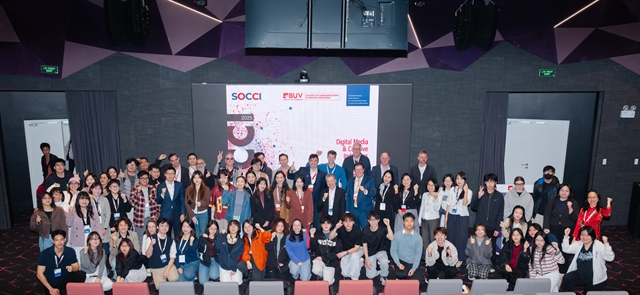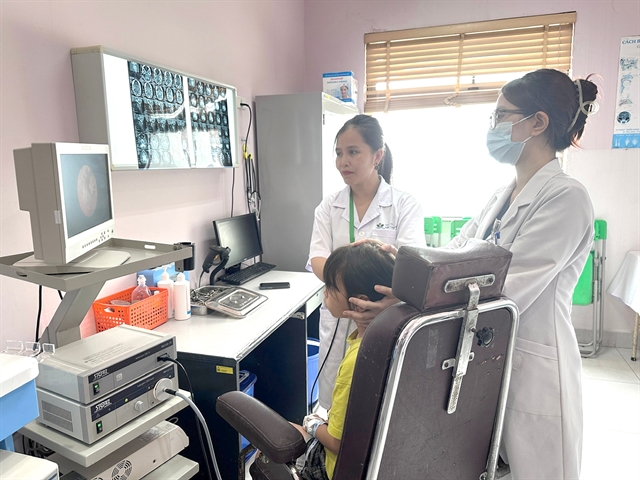 Society
Society

 |
| Dr Phí Thị Quỳnh Anh, Head of the Ear–Nose–Throat (ENT) Department at the National Children’s Hospital (white blouse, second from right) and colleagues pay a visit to a young patient after undergoing a surgery. VNA/VNS Photo Thùy Giang |
HÀ NỘI — Dr Phí Thị Quỳnh Anh, Head of the Ear–Nose–Throat Department at the National Children’s Hospital, has lost count of how many surgeries she has performed on young patients during nearly two decades in medicine. Yet one encounter with a 15-year-old boy from the northern mountainous province of Sơn La remains deeply etched in her memory.
Some time ago, C.C.K., a 15-year-old ethnic minority boy, shyly asked to see the doctor after his check-up. His face carried a quiet sadness. He was born into a poor family and had been diagnosed with a tumour in his left nasal cavity pressing on the optic nerve, causing his eye to bulge and his vision to deteriorate over time.
He told the doctor about his family’s hardships. His elder sister was also battling a tumour in her abdomen, already in the final stage and unresponsive to treatment.
Quỳnh Anh recalled the boy who softly said: “Doctor, I know I have a tumour, but if something happens to me, please don’t tell my mother. I don’t want her to be sad.”
“The compassion that boy had for his mother was truly moving.”
His mother, her thick hair coiled into a large bun typical of her ethnic group, earnestly asked the doctor whether her son could recover or if he would face the same fate as his sister.
The boy’s treatment was extremely challenging. Although the tumour was benign, it was detected late. The condition is very rare, and the surgery was particularly difficult because the tumour was as hard as stone and had invaded hard-to-reach areas such as the orbit and skull base. The risk of recurrence was high, and without careful treatment, the boy could lose sight in one or both eyes.
K. has undergone two surgeries to remove the tumour and continues to receive outpatient care and close follow-up.
Quỳnh Anh explained that the National Children’s Hospital, as the country’s leading paediatric facility, maintains international partnerships with many nations and medical specialties. For complex cases, the hospital can consult with top experts abroad, either online or in person, from countries such as the United States, France and Japan.
“In the coming months, a team of experts from the US-based organisation REI will come to work at our hospital. We plan to invite them for a consultation to determine the best possible treatment options for K,” she said.
The making of a surgeon
With nearly 20 years of experience, Quỳnh Anh recalls her time as a resident physician at the National ENT Hospital as an invaluable hands-on training ground that gave her extensive clinical experience.
“Resident doctors practically lived at the hospital,” she said. “In the past, hospitals had dormitories for residents who stayed on site, often working until at least 10pm.”
Out of about 500 students in her medical class, only around 70 passed the exams to continue residency training. At that time, each specialty accepted only two to four residents.
“That was just the first brick in the foundation of a doctor’s career,” she said. “Medicine requires lifelong learning. Science keeps evolving, diseases become more complex, so doctors must constantly study and adapt.”
Residency demanded mastery of both theory and clinical practice. Experience was gained most effectively through mentors and senior doctors, and she said patients themselves are also the best teachers.
At the National Children’s Hospital, a tertiary-level paediatric facility, she performs a wide range of surgeries from common procedures like tonsillectomies, adenoid removal and ventilation tube insertion to complex congenital or reconstructive operations such as branchial fistula repair, middle ear reconstruction, ear reshaping and tumour removal in the head and neck region.
 |
| Dr Phí Thị Quỳnh Anh instructs a resident doctor on how to perform an ear, nose and throat examination for a pediatric patient. VNA/VNS Photo Thùy Giang |
A typical operation may last 30 minutes to an hour, while complicated cases can stretch to three or four hours.
“In surgery, the idea of ‘simple’ or ‘complex’ is relative,” she said. “When a patient’s life is at stake, every operation must be approached with utmost care and focus. Even the smallest mistake can endanger the patient and sometimes we may never get a second chance to correct it.”
Beyond the operating room
Every day, Quỳnh Anh meets children from different backgrounds, and what troubles her most is that the most complex cases often come from families in hardship.
Among her patients are children born with hearing impairments who need cochlear implants, but the devices are prohibitively expensive and beyond the means of most families.
The ENT Department now provides specialised care for vulnerable children, particularly those with congenital or acquired hearing loss.
“If children with profound deafness are diagnosed and treated early,” she said. "They can live normal lives, attend school and integrate into society rather than growing up with permanent disabilities.”
Treatment typically involves both surgery to restore hearing function and speech therapy to help the child reintegrate into daily life. The process is long and demanding, requiring close cooperation among the hospital, family and community, and can last five to ten years depending on each case.
For Quỳnh Anh, every surgery brings not only experience but also deep emotional rewards.
“The greatest joy is seeing the smiles on our young patients’ faces when their health improves," she said. "That is the motivation that keeps me going on this lifelong journey as a paediatric ENT surgeon.” — VNS

.jpg)


